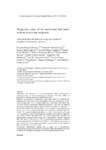Mostrar o rexistro simple do ítem
Prognostic value of the nutritional risk index in heart transplant recipients
| dc.contributor.author | Barge-Caballero, Eduardo | |
| dc.contributor.author | García-López, Fernando | |
| dc.contributor.author | Marzoa Rivas, Raquel | |
| dc.contributor.author | Barge-Caballero, Gonzalo | |
| dc.contributor.author | Couto-Mallón, David | |
| dc.contributor.author | Paniagua-Martín, María J. | |
| dc.contributor.author | Solla-Buceta, Miguel | |
| dc.contributor.author | Velasco-Sierra, Carlos | |
| dc.contributor.author | Pita-Gutiérrez, Francisco | |
| dc.contributor.author | Herrera-Noreña, José M. | |
| dc.contributor.author | Cuenca-Castillo, José J. | |
| dc.contributor.author | Vázquez Rodríguez, José Manuel | |
| dc.contributor.author | Crespo-Leiro, María Generosa | |
| dc.date.accessioned | 2017-08-22T12:08:33Z | |
| dc.date.issued | 2017-02-10 | |
| dc.identifier.citation | Barge-Caballero E, García-López F, Marzoa-Rivas R, et al. Prognostic value of the nutritional risk index in heart transplant recipients. Rev Esp Cardiol (Engl Ed.) [Internet]. 2017 Feb 10 [acceso 2017 Ago 22];70(8):639-645 | es_ES |
| dc.identifier.issn | 1885-5857 | |
| dc.identifier.uri | http://hdl.handle.net/2183/19350 | |
| dc.description.abstract | [Abstract] Introduction and objectives. To study the prognostic impact of preoperative nutritional status, as assessed through the nutritional risk index (NRI), on postoperative outcomes after heart transplantation (HT). Methods. We conducted a retrospective, single-center study of 574 patients who underwent HT from 1991 to 2014. Preoperative NRI was calculated as 1.519 × serum albumin (g/L) + 41.7 × (body weight [kg] / ideal body weight [kg]). The association between preoperative NRI and postoperative outcomes was analyzed by means of multivariable logistic regression and multivariable Cox regression. Results. Mean NRI before HT was 100.9 ± 9.9. According to this parameter, the prevalence of severe nutritional risk (NRI < 83.5), moderate nutritional risk (83.5 ≤ NRI < 97.5), and mild nutritional risk (97.5 ≤ NRI < 100) was 5%, 22%, and 10%, respectively. One year post-transplant mortality rates in these 4 categories were 18.2%, 25.3%, 7.9% and 10.2% (P < .001), respectively. The NRI was independently associated with a lower risk of postoperative infection (adjusted OR, 0.97; 95%CI, 0.95-1.00; P = .027) and prolonged postoperative ventilator support (adjusted OR, 0.96; 95%CI, 0.94-0.98; P = .001). Patients at moderate or severe nutritional risk had significantly higher 1-year post-HT mortality (adjusted HR, 1.55; 95%CI, 1.22-1.97; P < .001). Conclusions. Malnourished patients have a higher risk of postoperative complications and mortality after HT. Preoperative NRI determination may help to identify HT candidates who might benefit from nutritional intervention. | es_ES |
| dc.description.abstract | [Resumen] Introducción y objetivos. Analizar el impacto del estado nutricional preoperatorio, evaluado mediante el índice de riesgo nutricional (IRN), en el pronóstico tras el trasplante cardiaco (TxC). Métodos. Se realizó un estudio retrospectivo de 574 pacientes que recibieron un TxC entre 1991 y 2014 en un centro. El IRN preoperatorio se calculó como 1,519 × albúmina (g/l) + 41,7 × (peso real [kg] / peso ideal [kg]). La asociación entre IRN preoperatorio y eventos clínicos posoperatorios se analizó mediante modelos multivariables de regresión logística y regresión de Cox. Resultados. El IRN preoperatorio medio de la población del estudio era de 100,9 ± 9,9. Según este parámetro, las prevalencias de riesgo nutricional grave (IRN < 83,5), moderado (83,5 ≤ IRN < 97,5) y leve (97,5 ≤ IRN < 100) antes del TxC eran el 5, el 22 y el 10% respectivamente. Las tasas de mortalidad a 1 año tras el TxC en estas 4 categorías fueron del 18,2, el 25,3, el 7,9 y el 10,2% (p < 0,001) respectivamente. El IRN preoperatorio resultó predictor independiente de menor riesgo de infección posoperatoria (odds ratio ajustada [ORa] = 0,97; intervalo de confianza del 95% [IC95%], 0,95-1,00; p = 0,027) y ventilación mecánica prolongada posoperatoria (ORa = 0,96; IC95%, 0,94-0,98; p = 0,001). Los pacientes con riesgo nutricional moderado a grave mostraron mayor mortalidad a 1 año tras el TxC (hazard ratio ajustada = 1,55; IC95%, 1,22-1,97; p < 0,001). Conclusiones. Los pacientes desnutridos tienen mayor riesgo de complicaciones posoperatorias y muerte tras el TxC. La determinación del IRN podría facilitar la identificación de candidatos a TxC que se beneficien de intervenciones nutricionales en espera del órgano. | es_ES |
| dc.language.iso | eng | es_ES |
| dc.publisher | Elsevier para Sociedad Española de Cardiología | es_ES |
| dc.relation.uri | http://dx.doi.org/10.1016/j.rec.2017.01.005 | es_ES |
| dc.rights | Atribución-NoComercial-SinDerivadas 3.0 España | es_ES |
| dc.rights.uri | http://creativecommons.org/licenses/by-nc-nd/3.0/es/ | * |
| dc.subject | Nutritional risk index | es_ES |
| dc.subject | Heart transplant | es_ES |
| dc.subject | Malnourishment | es_ES |
| dc.subject | Outcomes | es_ES |
| dc.subject | Índice de riesgo nutricional | es_ES |
| dc.subject | Trasplante cardiaco | es_ES |
| dc.subject | Desnutrición | es_ES |
| dc.subject | Pronóstico | es_ES |
| dc.title | Prognostic value of the nutritional risk index in heart transplant recipients | es_ES |
| dc.title.alternative | Valor pronóstico del índice de riesgo nutricional en receptores de trasplante cardiaco | es_ES |
| dc.type | info:eu-repo/semantics/article | es_ES |
| dc.rights.access | info:eu-repo/semantics/embargoedAccess | es_ES |
| dc.date.embargoEndDate | 2018-02-10 | es_ES |
| dc.date.embargoLift | 2018-02-10 | |
| UDC.journalTitle | Revista Española de Cardiología (English Edition) | es_ES |
| UDC.volume | 70 | es_ES |
| UDC.issue | 8 | es_ES |
| UDC.startPage | 639 | es_ES |
| UDC.endPage | 645 | es_ES |
Ficheiros no ítem
Este ítem aparece na(s) seguinte(s) colección(s)
-
INIBIC-ICATC - Artigos [174]






